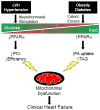Perturbations in the gene regulatory pathways controlling mitochondrial energy production in the failing heart
- PMID: 22964268
- PMCID: PMC3570640
- DOI: 10.1016/j.bbamcr.2012.08.015
Perturbations in the gene regulatory pathways controlling mitochondrial energy production in the failing heart
Abstract
The heart is an omnivore organ that requires constant energy production to match its functional demands. In the adult heart, adenosine-5'-triphosphate (ATP) production occurs mainly through mitochondrial fatty acid and glucose oxidation. The heart must constantly adapt its energy production in response to changes in substrate supply and work demands across diverse physiologic and pathophysiologic conditions. The cardiac myocyte maintains a high level of mitochondrial ATP production through a complex transcriptional regulatory network that is orchestrated by the members of the peroxisome proliferator-activated receptor gamma coactivator-1 (PGC-1) family. There is increasing evidence that during the development of cardiac hypertrophy and in the failing heart, the activity of this network, including PGC-1, is altered. This review summarizes our current understanding of the perturbations in the gene regulatory pathways that occur during the development of heart failure. An appreciation of the role this regulatory circuitry serves in the regulation of cardiac energy metabolism may unveil novel therapeutic targets aimed at the metabolic disturbances that presage heart failure. This article is part of a Special Issue entitled:Cardiomyocyte Biology: Cardiac Pathways of Differentiation, Metabolism and Contraction.
Copyright © 2012 Elsevier B.V. All rights reserved.
Figures



References
-
- Ingwall JS. On the hypothesis that the failing heart is energy starved: lessons learned from the metabolism of ATP and creatine. Current hypertension reports. 2006;8:457–464. - PubMed
-
- Neubauer S, Horn M, Cramer M, Harre K, Newell JB, Peters W, Pabst T, Ertl G, Hahn D, Ingwall JS, Kochsiek K. Myocardial phosphocreatine-to-ATP ratio is a predictor of mortality in patients with dilated cardiomyopathy. Circulation. 1997;96:2190–2196. - PubMed
-
- Jaswal JS, Keung W, Wang W, Ussher JR, Lopaschuk GD. Targeting fatty acid and carbohydrate oxidation--a novel therapeutic intervention in the ischemic and failing heart. Biochimica et biophysica acta. 2011;1813:1333–1350. - PubMed
-
- Sack MN, Rader TA, Park S, Bastin J, McCune SA, Kelly DP. Fatty acid oxidation enzyme gene expression is downregulated in the failing heart. Circulation. 1996;94:2837–2842. - PubMed
Publication types
MeSH terms
Substances
Grants and funding
LinkOut - more resources
Full Text Sources
Other Literature Sources
Medical

